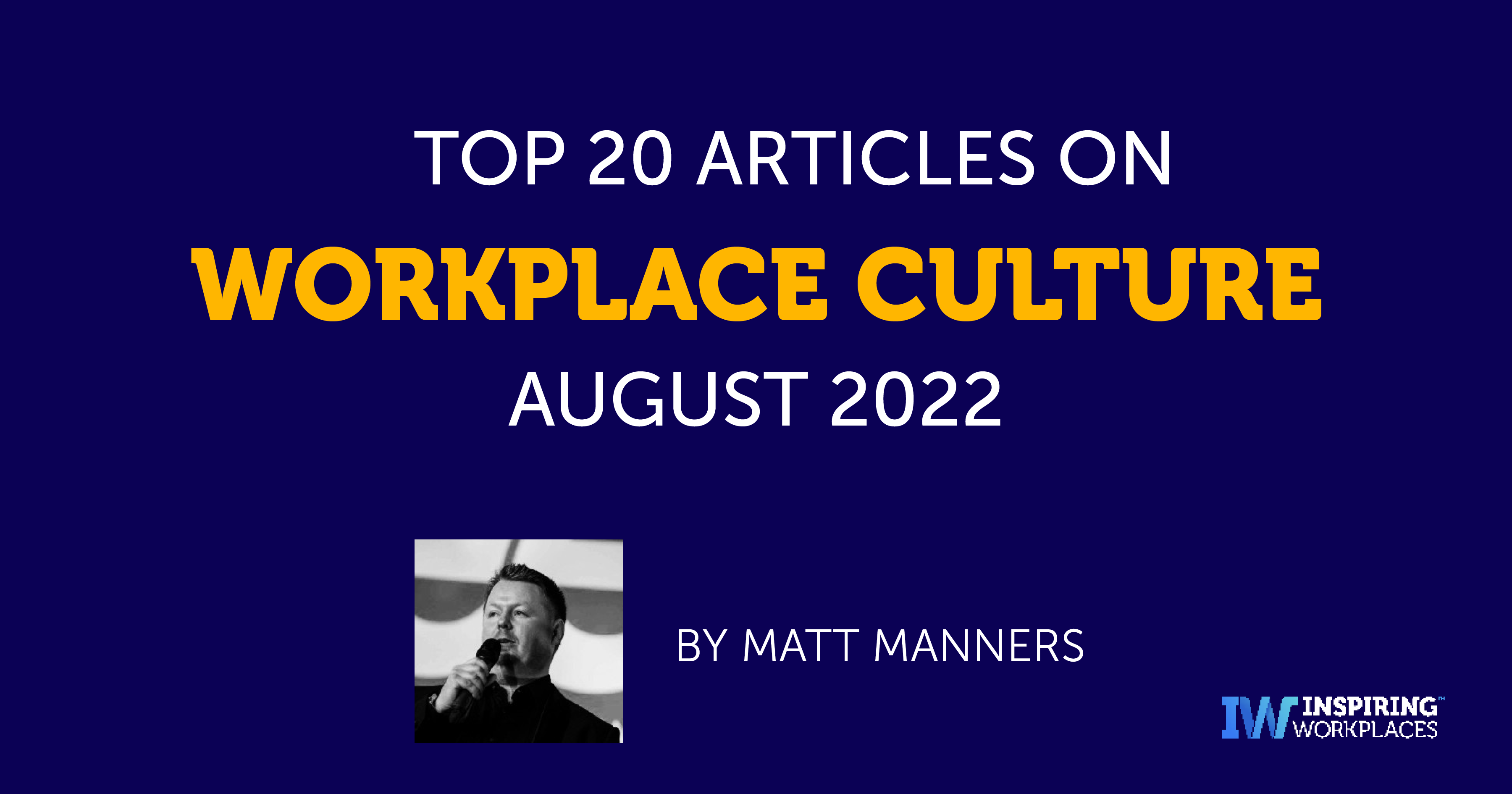
08th September 2022
Top 20 Articles on Workplace Culture for August 2022

Welcome to the Inspiring Workplaces Top 20 Articles on Workplace Culture for August 2022.
We want to help inform and inspire you from some of the best content out there. Each month we will consolidate these articles for you to help give you a quick and easy snapshot. To help drive you and your organisations forward.
The articles will be underpinned by six key elements that are reflected in our awards. They are:
- Wellbeing
- Culture
- Leadership
- Inclusion
- Employee Engagement
- Communication
Workplace Wellbeing: How to have a truly guilt free holiday this summer

Takeaways:
- Only 40% of UK employees take their full allocation of holiday
- A quarter regularly check emails while away
- 15% worked through for fear of falling behind.
By: Alice Weightman
Source: Evening Standard
Read the full article here.
Let’s make this the year we banish imposter syndrome forever

Takeaways: A 2019 survey conducted by The Hub Events found that around 90% of women experience imposter syndrome in the workplace.
By:Alice Weightman
Source: Evening Standard
Read the full article here.
Employee Wellbeing Starts at Work
Takeaways:
- When it comes to overall wellbeing, the
 quality of the work experience has 2.5 to 3 times the impact of the number of days or hours worked.
quality of the work experience has 2.5 to 3 times the impact of the number of days or hours worked. - In short, the quantity of work does matter, but the quality of work matters more.
- Those who think life would be better without work are wrong. Meaningful work is an important part of a fulfilling life. When Gallup asks people across the world what they want most, the most common reply is a good job.
- Only 20% of employees strongly agree that they like what they do every day. And even more feel chronically burnt out: 28% of U.S. employees say they feel burnt out at work very often or always.
By: Ryan Pendell
Source: Gallup
Read the full article here.
5 Effective Ways to Build a Winning Team
Takeaways:
- Having shared values seems
 like a fundamental concept, but you’d be surprised how often the core team is not on the same page
like a fundamental concept, but you’d be surprised how often the core team is not on the same page - Nothing kills a team (and your business) faster than negativity. Some people are naturally optimistic, while others are negative. Surround yourself with people who are “glass half full” and eliminate all of the toxic people from your team.
- The risk of not communicating overtly and clearly is that people will think you are not being transparent.
By: Lynn Power
Source: Entrepreneur
Read the full article here.
Mental Health Has Become a Business Imperative
Takeaways:

- Studies now show that nearly 81% of workers face some form of burnout or mental health issue, and 68% of employees say their daily work has been interrupted by these challenges.
- From our regular discussions with HR leaders around the world, it’s clear that the organizations outperforming their peers are those that have cultivated a strong sense of empathy and flexibility, developed new skills to address workforce needs, and extended holistic mental health support to employees.
- Research (a study of over 1,000 companies) shows that “healthy” organizations outperform their peers in a range of ways. Rates of absenteeism are almost 11 times more likely to be lower, and these employers are more than three times more likely to retain people.
By: Josh Bersin
Source: Sloan Review
Read the full article here.
Don’t Let Employee Engagement Wither in a Hybrid Office
Takeaways:
As evidenced by employee engagement surveys, burnout, and attrition across industries, employees’ social and emotional needs are no longer being met. Managers are in the best position to tackle this problem because of the personal relationships they have with each member of their team. But managers themselves need more support
By: Clara Shih
Source: Harvard Business Review
Read the full article here.
Malcolm Gladwell slams working from home: ‘What have you reduced your life to?’
Takeaways: “As we face the battle that all organizations are facing now in getting people back into the office, it’s really hard to explain this core psychological truth, which is we want you to have a feeling of belonging and to feel necessary.”
organizations are facing now in getting people back into the office, it’s really hard to explain this core psychological truth, which is we want you to have a feeling of belonging and to feel necessary.”
By: Ariel Zilber
Source: New York Post
Read the full article here.
What is proximity bias — and how can HR prevent it?
Takeaways:
- “Workplace proximity bias” is the term
 commonly used to describe employer prejudice against remote workers.
commonly used to describe employer prejudice against remote workers. - Global HR strategist Sonia Aranza said employers should be more intentional in trust-building to ensure longevity in hybrid work setups
By: Caroline Colvin
Source: HR Dive
Read the full article here.
Remote v office workers: the push for equitable experiences
Takeaways:
- A survey by Future Forum published in
 January found that 41% of executives are worried about proximity bias and favouritism towards in-office colleagues creeping into their business. This figure was up from 33% three months earlier.
January found that 41% of executives are worried about proximity bias and favouritism towards in-office colleagues creeping into their business. This figure was up from 33% three months earlier. - All employees crave a sense of belonging. It’s always been a driver of workplace happiness, but the pandemic crystallised its importance. Belonging increased employee happiness by 12% on average in the first few months of the crisis, according to research by employee engagement platform Glint.
- Creating equitable experiences is all well and good but the hard work will be undone without parity in career progression.
By: Rich McEachran
Source: Raconteur
Read the full article here.
Being an Introvert Doesn’t Make You a Bad Leader. In Fact, It Just Might Be Your Secret Weapon.

Takeaways: Even though quiet confident people aren’t loudly commanding, they make great leaders as they can easily get people in their confidence by establishing trust through careful listening.
By: Sofia Laurell
Source: Entrepreneur
Read the full article here.
Inclusive leadership: the way forward for business
Takeaways: Inclusion can have a dramatic impact on performance. According to Diversity Council Australia’s 2021-22 ‘inclusion@work index’, workers in inclusive teams are 11 times more likely to be highly effective than those in non-inclusive teams, six times more likely to provide excellent customer service, and four times less likely to leave their jobs in the next 12 months.
impact on performance. According to Diversity Council Australia’s 2021-22 ‘inclusion@work index’, workers in inclusive teams are 11 times more likely to be highly effective than those in non-inclusive teams, six times more likely to provide excellent customer service, and four times less likely to leave their jobs in the next 12 months.
By: Simon Webster
Source: Financial Review
Read the full article here.
6 Ways Leadership Teams Can Fuel Workplace Diversity and Inclusion
Takeaways:

It’s no coincidence that McDonald’s set competitive annual diversity goals for2025 that are directly tied to the compensation of executive vice presidents. You have to believe that failing to invest time and energy in improving organizational DE&I negatively, can affect your company’s performance. Putting it simply—the solution starts with your visible commitment to developing diversity-related KPIs for other leaders and managers.
By: Albrey Brown
Source: Talent Culture
Read the full article here.
6 Ways to Build a Strong Company Culture
Takeaways:
- Develop strong and authentic relationships.
 The key to building a strong company culture is ensuring that everyone is connected and has a sense of shared purpose.
The key to building a strong company culture is ensuring that everyone is connected and has a sense of shared purpose. - Teamwork improves the quality of your team members’ lives by making them feel like they’re part of something bigger than themselves.
By: Risha Grant
Source: LinkedIn
Read the full article here.
Creating a Space for Belonging at Work
Takeaways:
- Seeking to understand your people goes
 beyond who they are once they walk through the door. It’s a deeper level of recognizing their intricacies that extend beyond the workplace. Everything they go through plays a huge part in who they show up as each and every day. Welcoming your employees’ voices and input helps them feel safe and cared for.
beyond who they are once they walk through the door. It’s a deeper level of recognizing their intricacies that extend beyond the workplace. Everything they go through plays a huge part in who they show up as each and every day. Welcoming your employees’ voices and input helps them feel safe and cared for. - One of the biggest mistakes leaders continually display is making assumptions about people. Assumptions lead to microaggressions, misunderstanding, and otherwise harmful behaviors.
- Embrace a culture of belonging, and you will see your people grow and collaborate even more, which will produce all the positive business results for which you are aiming to achieve.
By: Heather R Younger
Source: LinkedIn
Read the full article here.
Why we need to stamp out the neurodiversity stigma
Takeaways:
- With the impact of global lockdowns
 putting a renewed focus on mental health, and Google searches for ‘neurodiversity’ peaking at a 300% increase, now is the time to address the issue and work to make a change.
putting a renewed focus on mental health, and Google searches for ‘neurodiversity’ peaking at a 300% increase, now is the time to address the issue and work to make a change. - With one in seven individuals being considered to have a neurodiverse condition – that being an umbrella term used to describe alternative thinking styles such as dyslexia, dyspraxia, dyscalculia, autism, and ADHD
- …50% of UK managers state that they would not hire neurodivergent talent
By: Jaime Graham
Source: HR Zone
Read the full article here.
Eight ways to strengthen your employees’ change muscles in the new era of work
Takeaways:
- Humans need social connection to thrive
 and flourish. Research shows that connection reduces anxiety and depression, increases happiness and strengthens the immune system. It also increases productivity. In fact, workplaces that facilitate the bringing together of people (even virtually) – not just for work, but also to socialise, play, eat, communicate and so on – achieve multiple benefits.
and flourish. Research shows that connection reduces anxiety and depression, increases happiness and strengthens the immune system. It also increases productivity. In fact, workplaces that facilitate the bringing together of people (even virtually) – not just for work, but also to socialise, play, eat, communicate and so on – achieve multiple benefits. - The stronger a person’s self-esteem, and the more constructive their mindset, the easier they will be able to embrace and adapt to change. However, relatively few people currently have the kind of rock-solid self-esteem and mindset that enables them to be fully resilient to life’s changes and challenges.
By: Martine Bolton
Source: Training Zone
Read full article here.
The Great Resignation is a crisis of belonging. Here’s the real way we organize ourselves at work
Takeaways:
- Like when managers evaluate their
 employees by hours worked rather than results. Employees who come in early and stay late aren’t necessarily more productive; we’ve all known people who put in long hours but accomplish relatively little.
employees by hours worked rather than results. Employees who come in early and stay late aren’t necessarily more productive; we’ve all known people who put in long hours but accomplish relatively little. - Leaders play a critical role in helping people experience this sense of belonging. The security of the people you lead hinges on this feeling of being central to–and valued by–the social network that is the organization.
- The simple act of being kind and empathetic toward people is the first step. A lack of genuine caring is like air—you don’t notice it when it’s there every day, yet when it’s gone it’s all you notice.
By: Anthony Silard
Source: Fortune
Read the full article here.
Gen Z workers demand flexibility, don’t want to be stuffed in a cubicle
Takeaways: Gen Z workers are expected to more than triple to 87 million people by 2030 in Australia, France, Germany, the Netherlands, the United Kingdom and the United States, accounting for 30 percent of total employment, according to a study by Oxford Economics.
than triple to 87 million people by 2030 in Australia, France, Germany, the Netherlands, the United Kingdom and the United States, accounting for 30 percent of total employment, according to a study by Oxford Economics.
By: Danielle Abril
Source: Washington Post
Read the full article here.
3 Ways Companies Make Work Purposeful
Takeaways:

Companies are trying to retain employees through better pay, flexible working conditions, and emphasis on the corporate mission. These are not proving successful because the real problem is people’s engagement with the work they actually do.
By: Michael Mankins, Eric Garton & Dan Schwartz
Source: Harvard Business Review
Read the full article here.
Can’t we all just belong
Takeaways: Over the past 50 years, there have been thousands of attempts to define talent. But the simplest typology of talent includes both competence and commitment.
been thousands of attempts to define talent. But the simplest typology of talent includes both competence and commitment.
By: Dave Ulrich
Source: Talent Quarterly
Read the full article here.

